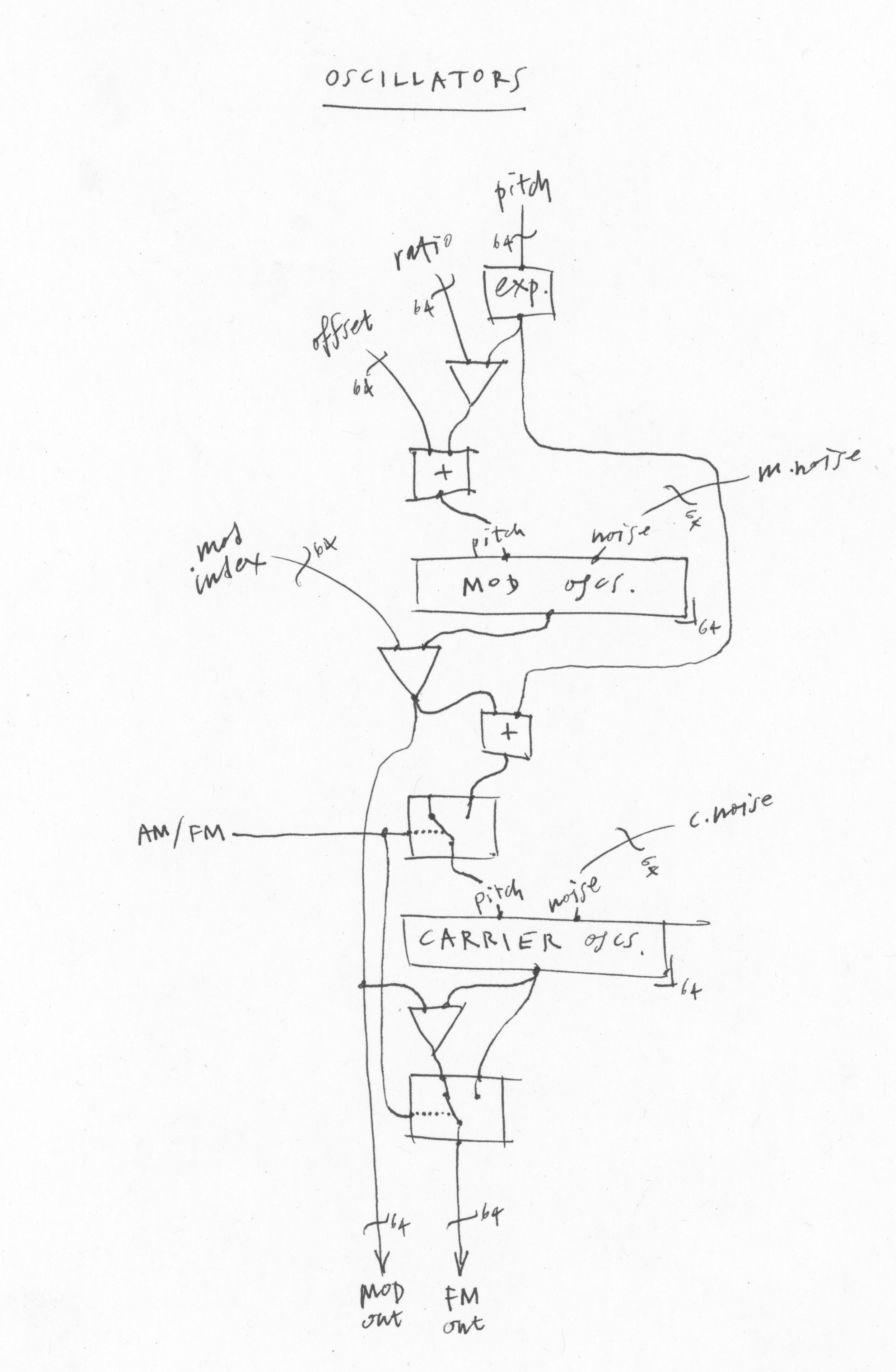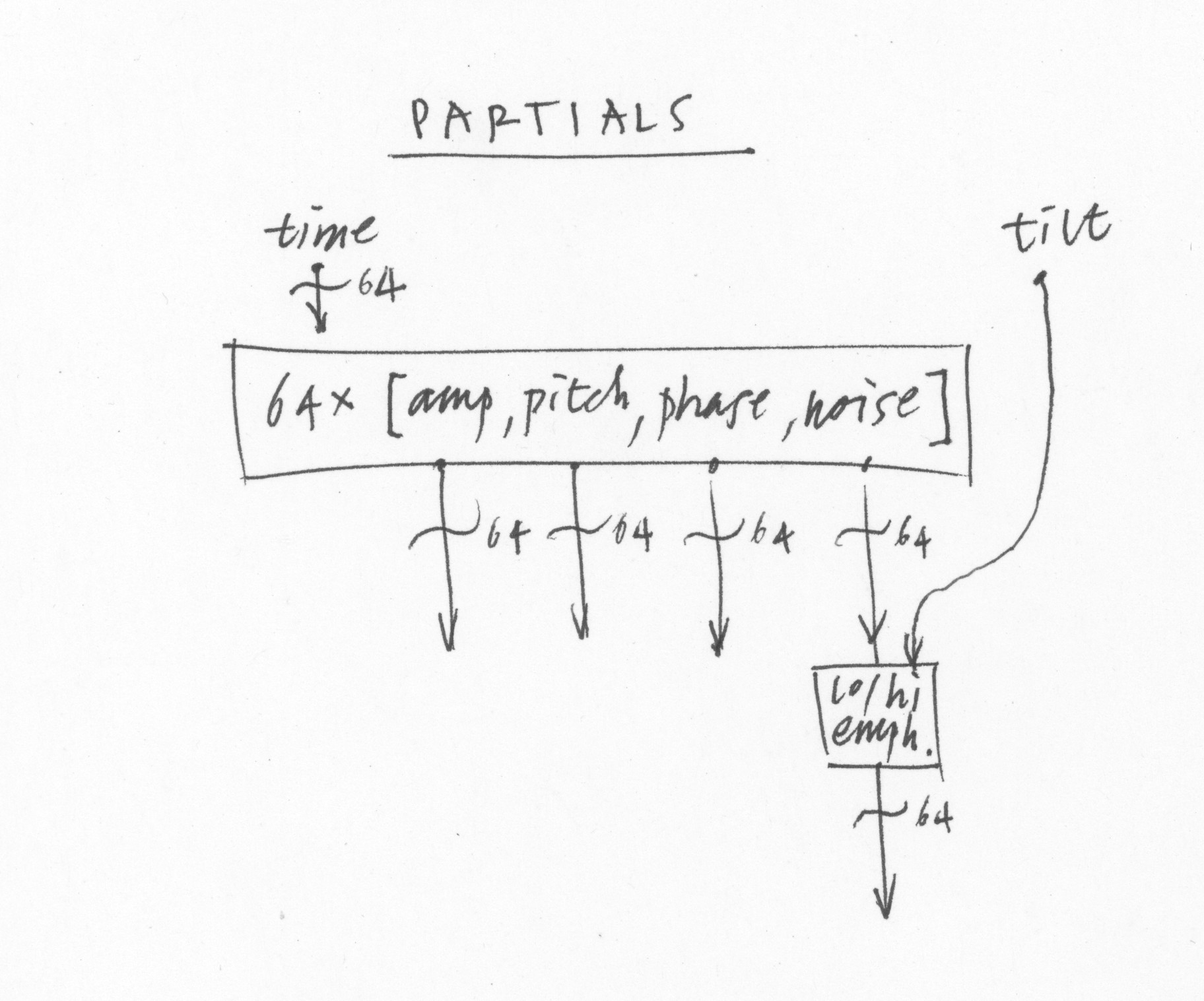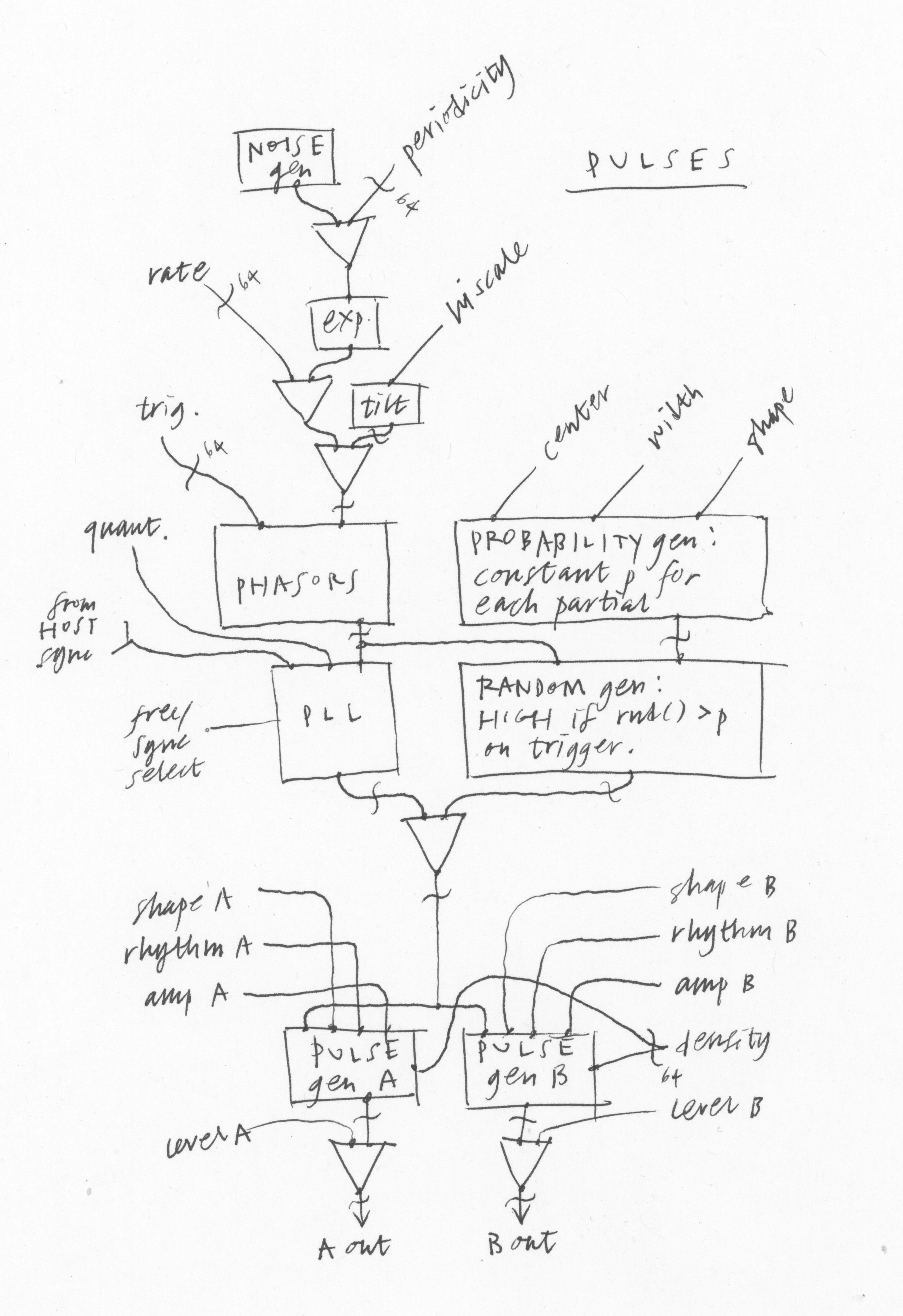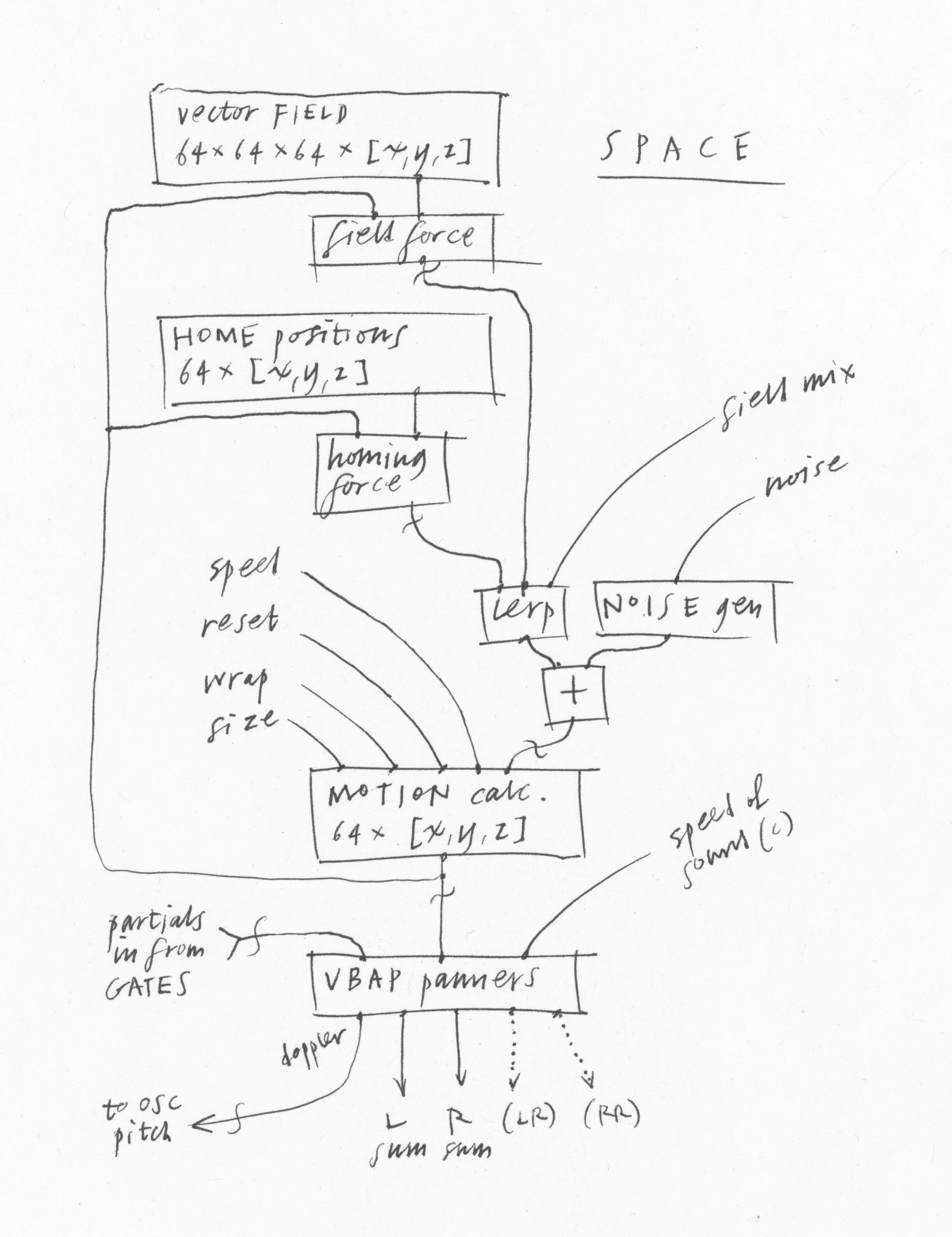
Sumu is an additive instrument that I've had in the works for a long time. Now that it's nearing completion and heading towards a public beta soon I'm going to break with the way I normally do things and put some detailed info out ahead of its release.

Sumu is another semi-modular instrument. It shares the general appearance of its patcher-in-the-center design with Aalto, Kaivo and Virta. As you can see, it's on the more complex end of the spectrum like Kaivo. Everything is visible at once and there are no tabs or menu pages to navigate, which suits the way I like to program a synthesizer tweaking a little something here, a little something there.
In the same way that Kaivo brought two different and compatible kinds of synthesis together, combining granular synthesis with physical modeling, Sumu combines advanced additive synthesis with FM synthesis.
What's most different about Sumu compared to my other synths is that the signals in the patcher are not just one channel of data, but 64—one for each partial in a sound! By keeping all these channels of data independent and still using the same patching interface, Sumu offers a very usable entry point into additive synthesis, and a range of musical possibilities that have only been approachable with high-end or academic tools or just coding everything yourself... until now.

Each of Sumu's oscillators is the simplest possible kind of FM:a single carrier+modulator pair. And the modulator can produce a variable amount of noise, which like the modulation ratio and depth can be controlled individually per oscillator. In a single voice there are 64 such pairs. Obviously a lot of sounds are possible with this setup—in fact, with the right parameters varying appropriately we can reproduce any musical sound very faithfully with this kind of oscillator bank.

There are a few ways of generating all of those control channels without the kind of painful per-partial editing that some of the first digital synths used. The first is the PARTIALS module up top, where you can see a diagram of all the 64 partials over time. This is like a sonogram style of diagram where x is time, y is pitch, and thickness of each like is amplitude. There is also an additional axis for noisiness at each partial.
A separate application will use the open-source Loris work by Kelly Fitz and Lippold Haken to analyze sounds and create partial maps.

Another way of generating control data is with the ENVELOPES module. It’s a normal envelope generator more or less—except that it generates 64 separate envelopes, one for each partial. Generally you would trigger them all at the same time, but each does have its own trigger so they can be separate. Using the “hi scale” parameter the high envelopes will be quicker than the low ones, making a very natural kind of lowpass contour to the sound.

Finally on the top row there’s the PULSES module. This combines an LFO and a randomness generator into one module. The intensity and other parameters of the pulses can be different for every partial. So this makes modulations that can be focused on a certain frequency range, but you don’t have to mess around editing partials one by one. You could also, for example, use the pulses to trigger the envelopes all at different times.
The PULSES module was inspired by my walks in a small canyon near my house, and listening to the very finely detailed and spatially spread sounds of water running in a small creek. Each drop contributes something to the sounds and the interplay between the parts and the whole is endlessly intriguing.
To make a water drop sound, two envelopes are needed at the same time: a rise in pitch and an exponential decay in amplitude. So PULSES lets you put out two such envelopes in sync. Then of course we generalize for a wider range of functions, so we can find out, what if the drops were quantized, or had different shapes over time? A voice turning into a running river is the kind of scene that additive synthesis can paint very sensitively. The PULSES module is designed to help create sounds like this.

The SPACE module lets us position each partial in the sound independently. Coming back to the creek idea, we can hear that certain pitch ranges happen in certain locations around us due to the water speed and the resonances of different cavities. This all paints a lively acoustic scene. By positioning many little drops independently, while allowing some variation, we can approximate this kind of liveliness.
This module centers around two kinds of data, a set of positions for each partial known as home, and a vector field: a direction [x, y, z] defined at each point in a 3-dimensional space. There will be a set of both the home and the field patterns to choose from. By offering these choices, and a small set of parameters controlling the motion of the partials, such as speed, the homing tendency, and the strength of the vector field, we can quickly create a wide variety of different sonic spaces without the tedium of editing each partial independently.
The RESONATORS module is very simple and inspired by the section of the Polymoog synthesizer with the same name. It’s simply three state-variable filters in parallel, with limited bandwidth and a bit of distortion for that “warm” sound. In Sumu, a synth we could otherwise describe as “very digital,” it’s nice to have a built-in way of adding a different flavor.
So I have this interface you see above, and a sound engine, and I'm working feverishly to marry the two. To enable all of the animations and the new pop-up menu, I wrote a whole new software layer that provides a completely GPU-based UI kit and interfaces directly with the VST3 library. Because it's been such a long process this time, I'm going to "build in public" more than I am used to doing, and have a public beta period. My plan is for this to start in December. Meanwhile I hope this information gives you interested folks something to whet your appetites, and even a basis for starting to think about what kinds of patches you might want to make.
Oh dear lord let me in!
i too am interested in the madrona discord / sumu preview
currently unable to enter :/
the links expire after 7 days. here's a new one!
https://discord.gg/p5XXD9D3
Hi Randy, would love an invite too, if possible. Love
Ok here's one more:
https://discord.gg/4VzcjxPS
Hi, I am interested in testing too, I am not sure if you send me a link earlier... I might have missed it.
Very excited to try this new synth!
Can you give us a chance to try it?
Ho no! I missed the discord link!!!!
New one please??
Would be very interested in testing out this new synth if that is still possible?
Thanks, Jamie
Me too! :)
+1 for another link! Such an awesome concept; I'm stoked, and can't wait to buy
would also love to join the discord! love your stuff randy :)
OK, here's a new link.
https://discord.gg/fcgPxNvA
Reminder that the beta is not out yet and nothing is really going on there at the moment! Right now I'm working on the app for making Sumu partial files, called Utu-view. That will be the first release on the discord, as soon as it's possible.
Still excited to see this! Please let me know how I can make presets for this!
please keep in touch for a beta announcement!
I'm eager to join the discord, could you post a new link?
Also, Is Sumu out yet? Is it? Huh, is it?
(hits f5)
How about now?
(hits f5 again)
How 'bout now?
:-)
I just watched the VUTU demo video and am now even more excited to try SUMU when it arrives ![]()
here's a newer link: https://discord.gg/BAJYprsU
Ahhh, did I miss my chance to try it out?
Any chance you can provide another link to the Discord, Randy?
Any chance to get access to the beta?
Sorry, I stopped adding people to the discord while I'm finishing the beta. This is because I have as many people as I think I can handle now. There's currently no beta to try anyway but I'm getting close!
Awesome, thank you for replying! Can't wait to use it :)
Thanks for replying Randy, best of lucks with what remains! :)
judging by the picture, it looks done to me. Let's do this thing already! (lol)
getting there...
The design looks fantastic and I hope you have as much fun programming it, as we will have trying out the upcoming version. I am very excited listening to SUMO´s sound. Thanks for the details and good luck merging the the elements into one thing which can be actually experienced.
I really appreciate the mind behind the development of the different Madrona modules that I have purchased. I'm looking forward to Vutu and Sumu! Do you have an idea of the release dates?
Maybe I can take advantage of one last link to download the beta ?
Warm hugs from France.